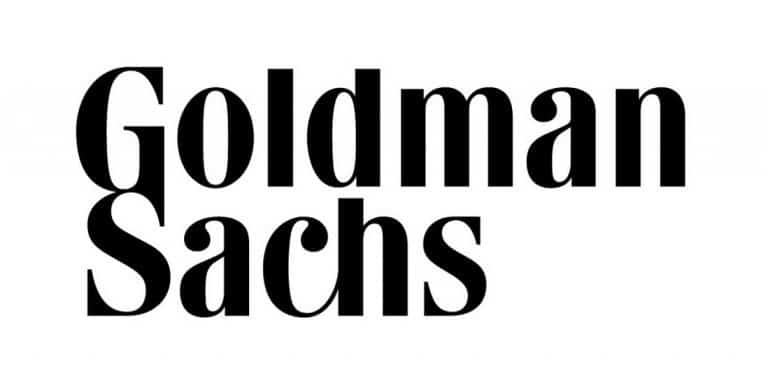Goldman Sachs logo is a simple yet effective design that has helped to make Goldman Sachs one of the most successful investment banks in the world. The logo has evolved over the years but has always maintained its core elements of simplicity, elegance, and trustworthiness.
The current logo features the company’s name in a simple sans-serif font. The letters are set in a blue square, and the word “Goldman” is slightly larger than the word “Sachs.” The logo perfectly reflects the company’s commitment to excellence and innovation.
But let’s take a look at the history, meaning, and significance of the Goldman Sachs logo to get a broad idea of how the brand and logo have been able to get to where it is today despite the odds.
What is Goldman Sachs?
Goldman Sachs is a financial conglomerate known as The Firm in the professional world. Many people became aware of him after the release of the film The Big Short, which was based on the events of the financial crisis.
Overview
In early 2020, the Goldman Sachs logo was quietly refreshed, removing its most recognizable design element: the GS ligature. Aside from separating the two uppercase letters, the new design ditches the round, soft font in favor of a much simpler option. Furthermore, the kerning has been slightly reduced.
According to Axios, a graphic design agency, Dalton Maag, redesigned the logo after the previous version was deemed “not legible enough at small sizes.” The agency also designed a custom font, Goldman Sans, released later in the year.
Lippincott created the Goldman Sachs “blue box” logo in 1970. It was intended to create a cohesive and unifying visual identity to help signal the company’s transition from an investment bank to an all-encompassing financial services provider.
The Evolution of the Goldman Sachs Logo
Goldman Sachs’ first logo was created in 1970, just over a century after the investment bank was founded. Furthermore, it hasn’t changed much since its inception, demonstrating its effectiveness.
1869-2020
The first Goldman Sachs logo consists of only one element: the company name “Goldman Sachs” in white within a sky-blue square. This design shows that the financial services provider is transparent and practical. The financial services provider chose a minimalistic design to emphasize its confidence, as evidenced by its expanded scope.
The name “Goldman Sachs” is written in two lines at the top of the square. The most important aspect of the logo, however, is the unique fusion of the letters “G” and “S” as well as the nearby letters “c” and “h.” Furthermore, the letters “h” and “d” have shortened legs at the top, “a” does not have a bottom stroke, and “n” and “m” have the same shape because they are both smooth.
2020-Present
The current Goldman Sachs logo design is similar to the previous version but differs in some ways. In the current version, there is no fusion of the letters “G” and “S” or “c” and “h.” Instead, the designers simplified the letters to make them more classic.
They also added serifs to the letters, which can now be found not only in the letters “G” and “S” but also in all other letters except “o.” In addition, the designers changed the blue tint of the square to a slight purple tone.
Elements of the Goldman Sachs Logo Design
Goldman Sachs’ logo is a sky-blue square with the company name written across two white lines. The name appears at the top of the square. Overall, the simplicity and limited color palette have resulted in a good logo design.
The Goldman Sachs logo has only two colors: white and sky blue. White represents purity, indicating that the company strives to achieve maximum prosperity through legal, honest, and fair means.
Fonts: Goldman Sachs created their personalized font to reflect their large and reputable financial services provider status—the original logo used both sans serif and serif letters. The company name is written entirely in serifs in the current logo. Furthermore, the Univers, Sabon, and Roboto fonts are used in various media.
What Is the Symbol for Goldman Sachs?
]There is no graphical symbol for Goldman Sachs, as the badge is based on lettering set in bold white characters across a light-blue square. Goldman Sachs is traded under the New York Stock Exchange symbol GS.
What Is the Motto of Goldman Sachs?
Goldman Sachs’ current motto is “You Can Money.” This version was introduced by the company in 2019. Before that, GS used another slogan, “Our Client’s Interests Always Come First,” which perfectly reflects the company’s values and approach and explains its global success and reputation.
Who Founded Goldman Sachs?
Marcus Goldman, a former German schoolteacher, founded Goldman Sachs in New York in 1869. Initially, the firm traded promissory notes but expanded into consulting and intermediary services. The founder’s son and second son-in-law joined the firm in 1885, and the name was changed to Goldman Sachs & Co.
Is Goldman Sachs a Trademark?
Goldman Sachs is one of the largest investment banks in the world. Throughout its 150-year history, Goldman Sachs has earned a reputation as one of the best investment banks for wealthy clients, and it has evolved from a financial institution to a full-fledged global brand.
The History of Goldman Sachs
Marcus Goldman founded Goldman Sachs, a US multinational financial services company and investment bank, in Lower Manhattan, New York 1869. By December 2016, the company had offices in over 30 countries.
Goldman Sachs offers various services, including mergers and acquisitions, asset management, security underwriting, and brokerage. It also provides traditional banking services through its Goldman Sachs Bank USA subsidiary.
Origin from the Beginning
Marcus Goldman established Goldman Sachs in New York in 1869. Samuel Sachs, his son-in-law, was hired by the company in 1882. In 1885, Goldman’s son Henry and another son-in-law, Ludwig Dreyfuss, joined the firm, and was renamed Goldman Sachs & Co.
Goldman Sachs joined the NYSE in 1896 and pioneered the use of commercial papers by entrepreneurs. The company’s capital had grown to $1.6 million by 1898.
Henry Goldman resigned from Goldman Sachs in 1917, under increasing pressure from other partners due to his pro-Germany stance. The family completely controlled Goldman Sachs until 1918, when Waddill Catchings joined the firm. Catchings had the largest partnership stake in Goldman Sachs by 1928.
In December 1928, Goldman Sachs established the Goldman Sachs Trading Corp., a closed-end fund. During the 1929 Stock Market Crash, the fund failed amid allegations that Goldman had engaged in insider trading and share price manipulation.
Mid-1900s
In 1930, Goldman Sachs replaced senior partner Catchings with Sidney Weinberg. Weinberg immediately shifted the firm’s emphasis from trading to investment banking. His actions aided in mending some of the company’s reputational damage.
Goldman Sachs served as the primary advisor during Ford’s initial public offering (IPO) in 1956, a significant accomplishment on Wall Street at the time. Under Weinberg’s leadership, the company established a municipal bond department and an investment research division and became a pioneer in risk arbitrage.
Gus Levy, a securities trader, joined Goldman Sachs in the 1950s when the firm was divided into two factions: securities trading and investment banking. Levy pioneered Block trading, and Goldman Sachs established it under his leadership. Because of Weinberg’s enormous clout, the company established an investment banking division in 1956 to focus on Weinberg.
Goldman Sachs relocated its headquarters to 20 Broad Street in New York City in 1957.
Levy took over as senior partner from Weinberg in 1969 and rebuilt Goldman Sachs’ trading franchise. Levy is best known for coining the company’s famous mantra of “being greedy long-term,” which suggests that short-term losses are acceptable as long as money is made in the long run.
That same year, partners invested nearly all their profits into the company. Weinberg remained a senior partner at Goldman Sachs until his death in July of that year.
Read Also: Berkshire Hathaway Logo: Evolution & History
Penn Central Transportation Co. went bankrupt in 1970, leaving over $80 million in unused commercial paper, most of which came from Goldman Sachs. The bankruptcy was devastating, and the subsequent lawsuits, particularly by the SEC, threatened Goldman Sachs’ partnership capital, reputation, and existence. As a result of this bankruptcy, every commercial paper issuer is now required to obtain credit ratings from various credit rating agencies.
In 1970, Goldman Sachs opened its first overseas branch in London, and in 1972, it established a fixed income section and a Private Wealth Management section. During its bid to prevent a hostile takeover of Electric Storage Battery by rival firms Morgan Stanley and International Nickel in 1974, the firm initiated the “white knight” plan.
In 1996, John C. Whitehead and John L. Weinberg (Sidney Weinberg’s son) were appointed senior partners, reiterating Goldman Sachs’ co-leadership structure. One of their moves was to establish 14 business principles that the company still claims to follow.
Late 1900s
Goldman Sachs acquired commodities trading firm J. Aron & Co in November 1981, merging it with its Fixed Income division and renaming it Fixed Income, Commodities, and Currencies. J. Aron was involved in the gold and coffee markets before the merger, and Lloyd Blankfein (ex-Goldman CEO) joined the company due to the merger.
Goldman Sachs established the Asset Management division 1986, managing most of its hedge and mutual funds. That same year, the firm also underwrote Microsoft’s initial public offering, advised General Electric on its takeover of RCA, became the first US bank to be named one of the top ten best UK mergers and acquisitions, and joined the Tokyo and London stock exchanges.
Stephen Friedman and Robert Rubin joined Goldman Sachs as co-senior partners in 1990. They promised to concentrate on the firm’s globalization efforts to strengthen the trading, merger, and acquisition lines. During their tenure as co-senior partners, Goldman Sachs pioneered paperless trading on the NYSE and oversaw the first-ever global IPO by an American corporation.
The Goldman Sachs Commodity Index was launched in 1994 when the company opened its first location in Beijing, China. Nonetheless, Rubin and Friedman left Goldman Sachs in the same year, and Jon Corzine took over as CEO.
Rubin was chastised in Congress for transferring $20 billion from a Treasury Department account in his possession to save Mexican bonds, which Goldman Sachs had heavily distributed. Goldman Sachs and another firm were confirmed to be trading on the Mexican Bolsa stock exchange in November 1994. The 1994 Mexican economic crisis threatened to devalue Goldman Sachs’ Mexican bonds.
Read Also: Ring Logo: History, Evolution & Meaning
Goldman Sachs underwrote the Yahoo! IPO in April 1996. Two years later, it was the co-lead overseer of the NTTDoCoMo IPO, which was reportedly worth $2 trillion. Goldman Sachs paid $531 million for Hull Trading Company in 1999. After decades of debate among the partners, GoldmaAfter decades of debate among the partners, n Sachs became a public corporation in May 1999.
The general public purchased 12.6% of Goldman Sachs, and the company’s 221 former partners received 48.3% after the initial public offering. Non-partner employees received a 21.2% stake in the company, with the remaining 17.9% held by two long-term investors (Assn and Sumitomo Bank Ltd) and retired Goldman Sachs partners.
The cost of each share was $53. Following the IPO, Henry Paulson took over as CEO and Chairman of Goldman Sachs, succeeding Jon Corzine.
The 2000s
Goldman Sachs paid $6.3 billion for Spear, Leeds & Kellogg in September 2000. It was one of the NYSE’s largest specialty companies. In January 2000, the firm and Brothers oversaw the World Bank’s first online bond offering.
In March 2003, Goldman Sachs acquired a 45% stake in a joint venture with Australian investment bank JBWere. The following month, Goldman Sachs acquired The Ayco Company, a fee-based financial counseling firm.
Four years after Goldman Sachs’ report on the rising “BRIC” economies (Brazil, Russia, China, and India) in 2001, the firm released a list of its “Next Eleven” countries based on criteria such as political maturity, macroeconomic stability, educational quality, and openness of investment and trade policies.
The countries represented were the Philippines, Turkey, Vietnam, South Korea, Iran, Pakistan, Mexico, Nigeria, Indonesia, Bangladesh, and Egypt.
Lloyd Blankfein took over as CEO and Chairman of Goldman Sachs in May 2006, succeeding Henry Paulson, who had left the company to become US Secretary of the Treasury. Goldman Sachs and CanWest Global Communications purchased Alliance Atlantis, which owned the rights to the CSI series, in January 2007.
Conclusion
Goldman Sachs is a multinational financial services provider and investment bank headquartered in New York City’s Lower Manhattan. Marcus Goldman founded it in 1869, and it had regional headquarters in Salt Lake City, London, Warsaw, Hong Kong, Tokyo, and Bangalore, as well as offices in other major financial centers around the world.
Goldman Sachs provides investment management, asset management services, prime brokerage, and investment banking (restructuring, mergers, and acquisitions advice). Securities, credit products, mortgage-backed securities, equities, equity derivatives, currencies, insurance-linked securities, commodities, futures contracts, structured products, and options are all traded through it.
Goldman Sachs manages hedge, private equity, real estate, and credit funds. It owns Goldman Sachs Bank and designs custom-made and complex financial products. It trades both for its account and for its clients’ accounts.
Goldman Sachs invests in and secures financing for startup companies, and it frequently receives additional business when the firms launch initial public offerings (IPOs). Goldman Sachs oversaw notable IPOs such as Robinhood Markets, Twitter, Bumble, Las Vegas Sands, FIGS, Toast, Inc., and Coupang.
The company employs over 32,000 people worldwide and had total assets of $938.55 billion as of 2012.
Related Articles
- RETIREMENT AGE IN TEXAS: Best Easy Guide & Rules In 2023 (Updated)
- CASH APP LOGO: Meaning, Font, Card and Taxes
- Ohio Small Business Grants in 2023 for any Business(Updated!)
- Private Wealth Management: Overview & 10 Best Private Management Firms in 2023
- Investment Banking Analyst: Job Description, Skills, Resume & Salary In The US






